Key takeaways:
- Eco-friendly supply chains prioritize sustainability through minimal waste, local sourcing, and transparency in materials sourcing.
- Adopting sustainable practices leads to cost savings, enhanced brand loyalty, and alignment with consumer values, particularly in the cannabis industry.
- Challenges in implementing eco-friendly methods include high initial investment costs, difficulty sourcing sustainable materials, and a lack of education among stakeholders.
- Personal experiences with sustainability highlight the impact of individual choices, the importance of community support, and the need for simplification in promoting eco-friendly practices.
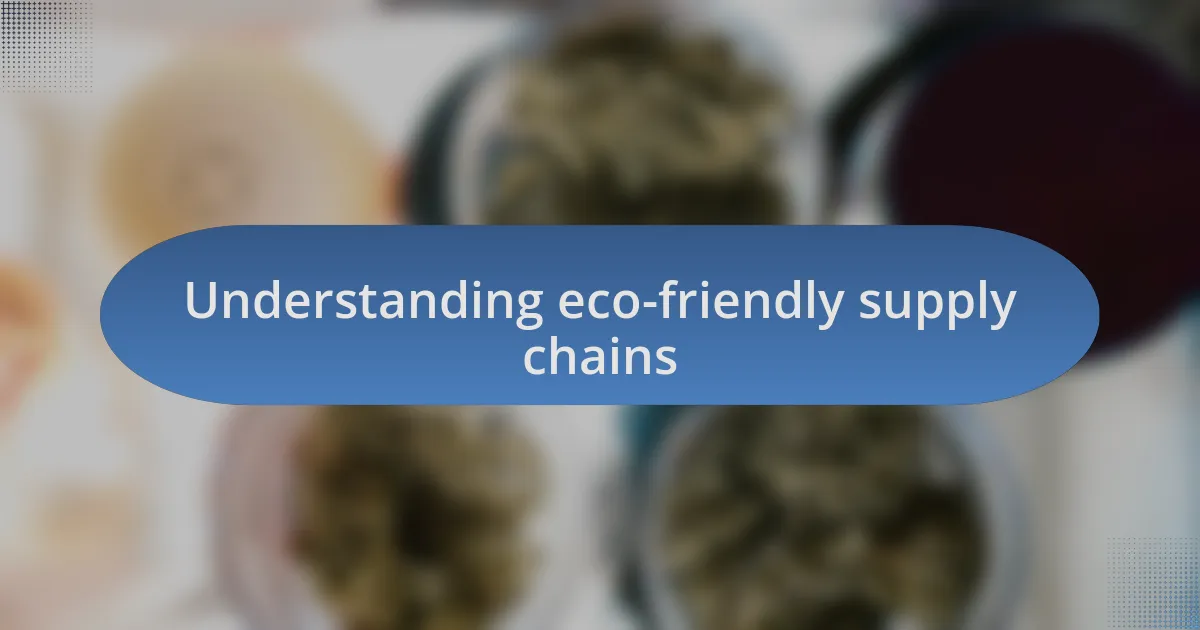
Understanding eco-friendly supply chains
Understanding eco-friendly supply chains involves a deep examination of how products are sourced, produced, and delivered with sustainability at the forefront. I remember visiting a local cannabis farm and being struck by how they operated with a focus on organic farming practices. It made me wonder—how often do we consider the origins of the products we consume and their impact on the planet?
In an eco-friendly supply chain, every step is meticulously crafted to minimize waste and reduce carbon footprints. I often think back to conversations I’ve had with supply chain experts who emphasized the importance of transparency in sourcing materials. Isn’t it fascinating how a simple change in supplier can lead to a ripple effect that benefits the environment?
The real beauty of eco-friendly supply chains lies in their potential to create circular economies. For instance, I recall a workshop where innovators shared ideas on repurposing waste materials from cannabis cultivation. It struck me that each small action contributes to a larger goal—one that involves nurturing our planet rather than depleting it. Isn’t it encouraging to see that change is not just possible, but already happening?
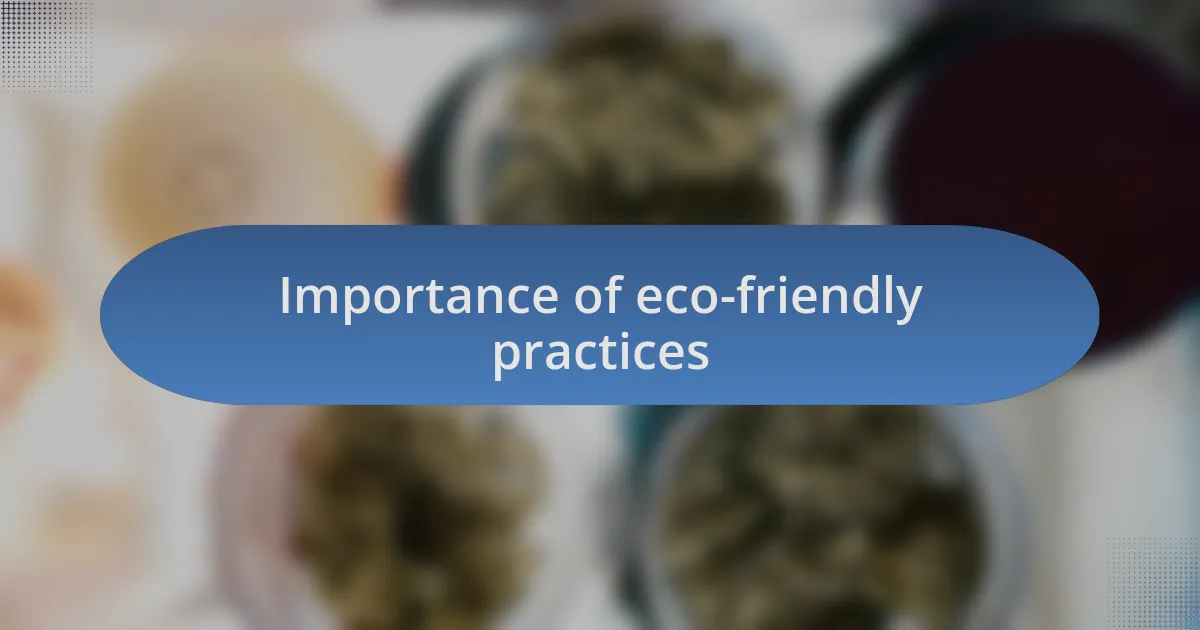
Importance of eco-friendly practices
Eco-friendly practices are pivotal because they ensure the long-term sustainability of our planet. When I first learned about the impact of water usage in cannabis cultivation, it opened my eyes. Wouldn’t it be great if every grower sought to minimize their water footprint, knowing that every drop saved contributes to a healthier ecosystem?
Moreover, adopting eco-friendly practices can enhance a company’s reputation and align it with consumer values. I was surprised during a recent cannabis expo to see how many people gravitate towards brands that prioritize environmental responsibility. Isn’t it amazing that our purchasing decisions can directly influence how businesses operate and contribute to a greener planet?
Lastly, sustainable practices in supply chains can lead to cost savings in the long run. I had a conversation with a farmer who switched to renewable energy for their operation and mentioned their significant reduction in energy costs. Have you ever considered how investing in sustainability today can lead to greater financial and environmental benefits tomorrow?
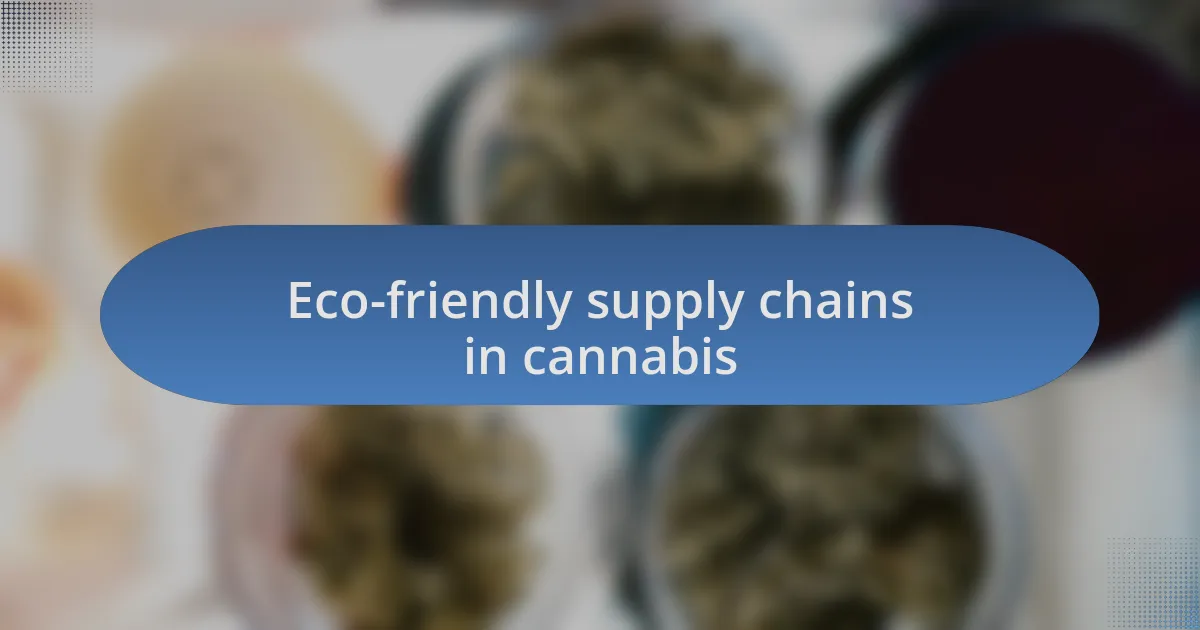
Eco-friendly supply chains in cannabis
One significant aspect of eco-friendly supply chains in cannabis is the use of biodegradable packaging. I remember attending a panel discussion where a brand showcased their shift from plastic to compostable materials. Their passion for reducing landfill waste was contagious—don’t you think we should all consider how our choices affect the environment?
Transportation practices also play a crucial role in creating an eco-friendly supply chain. I often think about the emissions that come from delivering products over long distances. This realization makes me appreciate companies that prioritize local sourcing. It’s uplifting to see businesses striving not just for profit, but also for lower carbon footprints. Who wouldn’t want to support a brand that values the health of our planet?
Moreover, incorporating renewable energy sources in cultivation and production processes can truly reshape the cannabis industry. I spoke with a cultivator who invested in solar panels for their facility, and they couldn’t emphasize enough how empowering it felt to harness natural energy. Doesn’t it inspire confidence when a business actively seeks to minimize their ecological impact while providing a quality product?
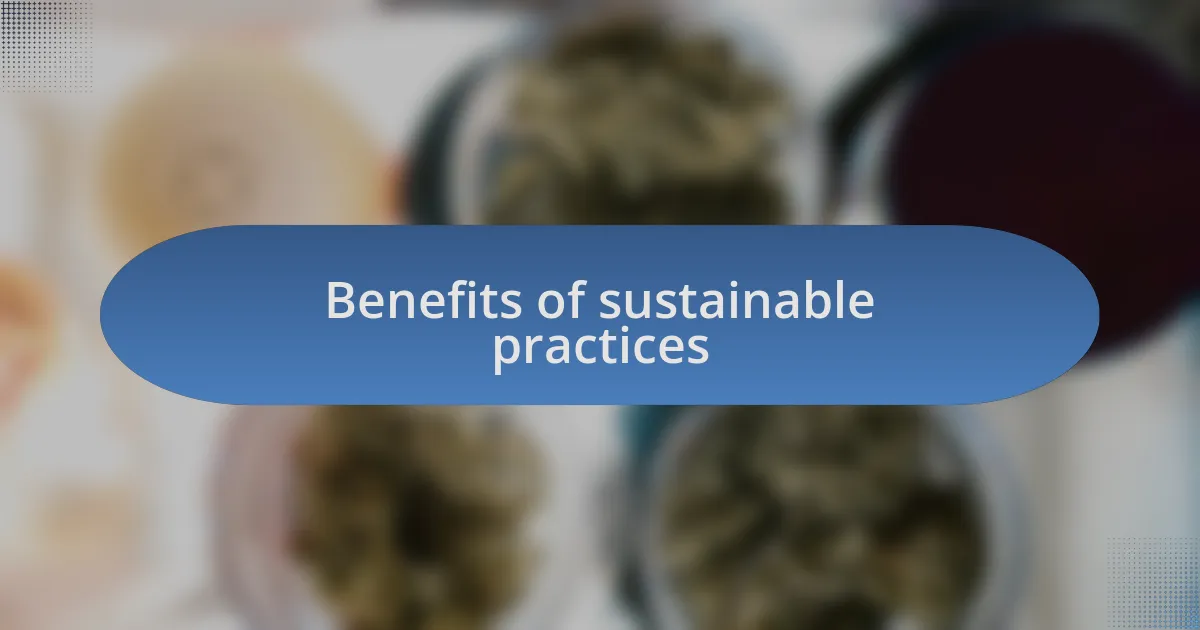
Benefits of sustainable practices
One of the major benefits of sustainable practices is cost savings in the long run. I recall a conversation with a fellow entrepreneur who switched to energy-efficient lighting in their grow operation. They mentioned how their initial investment paid off within a year, leading to lower utility bills. Isn’t it fascinating how going green can also be a smart financial move?
Another significant advantage is the potential for enhanced brand loyalty. When I visited a cannabis shop that actively promoted its sustainable practices, the atmosphere felt different. Customers were genuinely excited to support a brand that shared their values. Don’t you think that connecting with consumers on this level not only strengthens relationships but also promotes responsible consumption?
Lastly, adopting sustainable practices can help companies stay ahead of regulations. During a recent industry conference, I heard experts discussing impending environmental laws that could impact the cannabis sector. Businesses that proactively embrace eco-friendly approaches will be better positioned to adapt. Isn’t it wise to anticipate changes to the landscape rather than scrambling to catch up later?
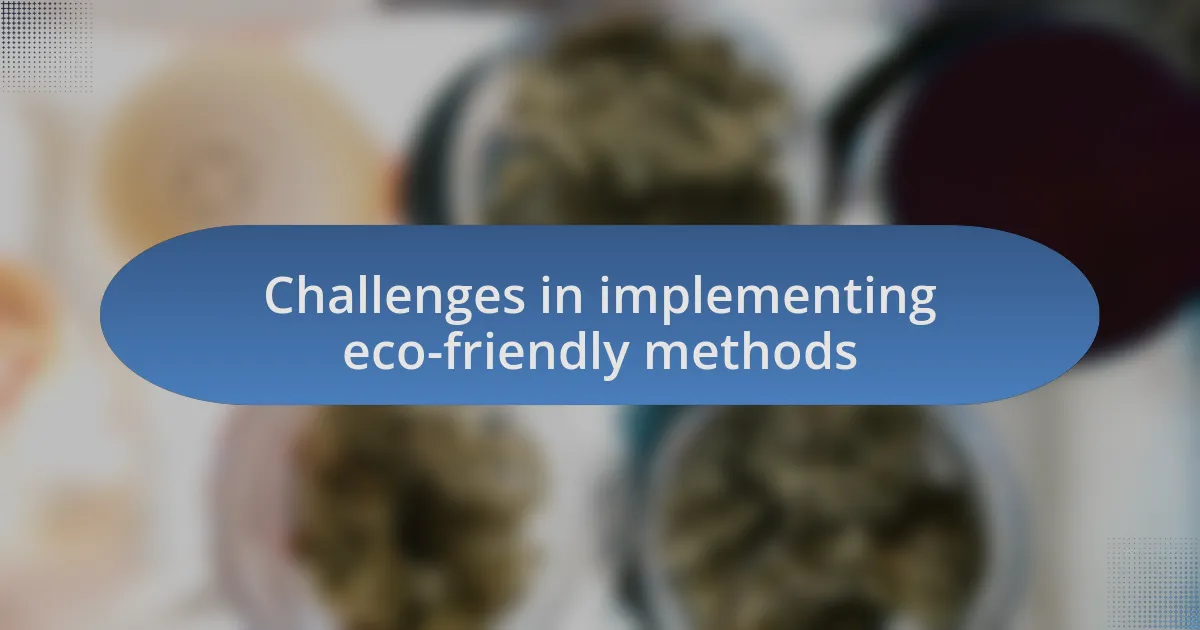
Challenges in implementing eco-friendly methods
Implementing eco-friendly methods in the cannabis supply chain often comes with significant challenges. One of the biggest hurdles I’ve noticed is the initial investment required for sustainable technology. I was at a trade show where a grower shared their struggle to afford bioenergy solutions, highlighting how budget constraints can stall progress. That experience made me wonder, how many businesses are left stuck in a cycle of outdated practices simply due to financial limitations?
Another challenge is the complexity of sourcing sustainable materials. I remember chatting with a packaging supplier who faced difficulties in finding eco-friendly options that met industry standards. It struck me how, in an industry where quality is paramount, the lack of reliable green alternatives can create a dilemma. Is it fair to sacrifice quality for sustainability, or should both ideals go hand in hand?
Lastly, there’s the issue of education and awareness among stakeholders. During a workshop, I witnessed many industry professionals who were genuinely unsure of what sustainable practices entailed. This lack of understanding can hinder collaboration and slow down the adoption of eco-friendly methods. It’s vital for us to foster open discussions and share insights if we want to overcome this barrier together, wouldn’t you agree?
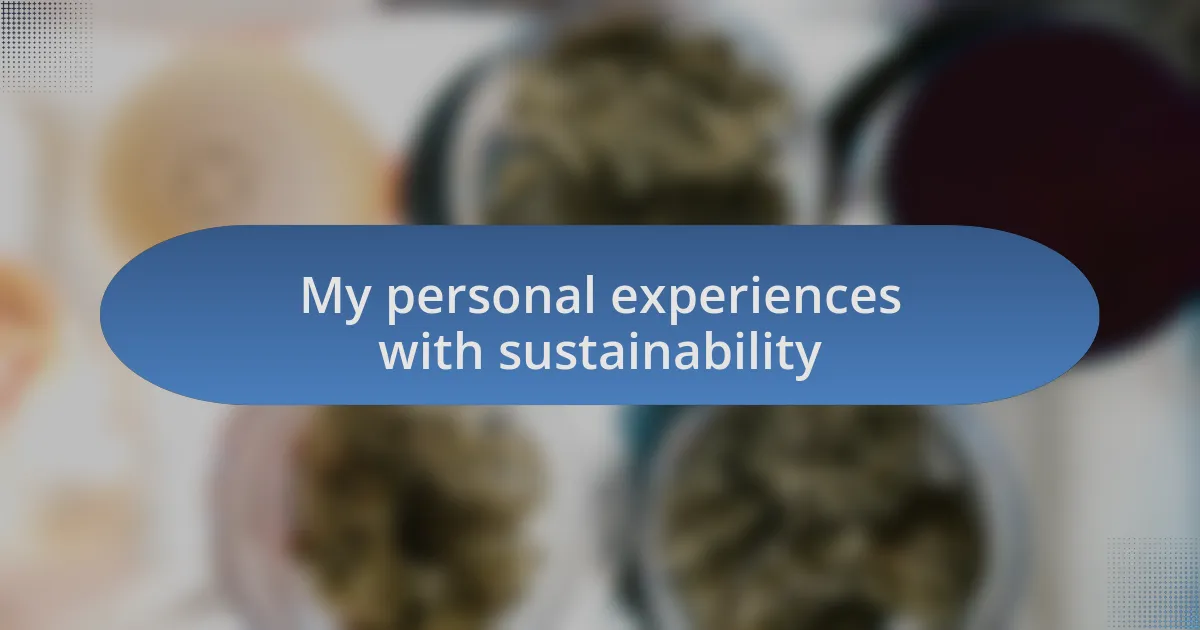
My personal experiences with sustainability
I’ve had some eye-opening experiences with sustainability that really shaped my views on eco-friendly practices. I recall attending a workshop where I learned about composting organic waste. It was inspiring to see how a simple practice could significantly reduce landfill use while enriching soil quality. The moment I realized that our everyday choices could have such a large impact left me determined to incorporate more sustainable practices in my life.
On a personal note, I remember the first time I opted for biodegradable packaging in my own product line. Initially, I felt apprehensive about the potential cost increase, but seeing the positive feedback from customers who valued the eco-friendly choice was incredibly rewarding. It made me realize that sustainability can not only align with ethical values but also resonate deeply with consumers’ hearts. Don’t you think that when we see ourselves reflected in our choices, it ignites a spark for change?
Lastly, I’ve had my share of trials, too. While volunteering for a local eco-initiative, I encountered challenges in rallying community support. Many were eager to help but felt overwhelmed by the details of what sustainable living entailed. This experience made me appreciate the importance of simplifying concepts while making them relatable. I often wonder, how do we bridge those gaps and encourage more people to embrace sustainable practices with open arms?